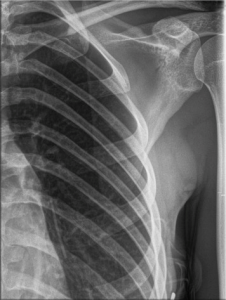
Nexplanon, a contraceptive implant promoted as Long Acting Reversible Contraceptive, is a single-rod, progestogen-only implant measuring 4 cm in length and 2 mm in diameter. It is not biodegradable, and it contains 68 mg etonogestrel.
Nexplanon should be placed subdermally at the inner side of the upper nondominant arm.
Subdermal contraceptive implant embolism to a pulmonary artery is an emerging iatrogenic condition.
This case was reported in The Annals of Thoracic Surgery.
An 18-year old woman underwent a voluntary termination of pregnancy in July 2014 and had a concomitant subdermal contraceptive implant (Nexplanon) inside her left upper arm.
During the procedure, the performed an inappropriate movement of flexion of her elbow. Because the gynecologist could not feel for the device to ensure that was placed correctly, a nonhormonal birth control method was advised and upper arm roentgenography was prescribed to check the device location. As the patient presented with no symptoms, she did not attend the outpatient clinic until March 2015. At that time, she asked for the removal of the device because of unfavorable change in her menstrual bleeding pattern. Examination and roentgenology of the patient’s arm failed to localize the implant, and it was deduced that it had migrated elsewhere. Chest radiography and computed tomography confirmed that the device was lodged in a subsegmental branch of the left lower lobe pulmonary artery.
The implant was removed from the pulmonary artery thoracoscopically, thereby avoiding the need of thoracotomy or lung resection.
This entry was posted
on Wednesday, May 17th, 2017 at 6:00 pm and is filed under News & Commentary.
You can follow any responses to this entry through the RSS 2.0 feed.
You can skip to the end and leave a response. Pinging is currently not allowed.
Contraceptive Implant Embolism Into the Pulmonary Artery
Nexplanon, a contraceptive implant promoted as Long Acting Reversible Contraceptive, is a single-rod, progestogen-only implant measuring 4 cm in length and 2 mm in diameter. It is not biodegradable, and it contains 68 mg etonogestrel.
Nexplanon should be placed subdermally at the inner side of the upper nondominant arm.
Subdermal contraceptive implant embolism to a pulmonary artery is an emerging iatrogenic condition.
This case was reported in The Annals of Thoracic Surgery.
An 18-year old woman underwent a voluntary termination of pregnancy in July 2014 and had a concomitant subdermal contraceptive implant (Nexplanon) inside her left upper arm.
During the procedure, the performed an inappropriate movement of flexion of her elbow. Because the gynecologist could not feel for the device to ensure that was placed correctly, a nonhormonal birth control method was advised and upper arm roentgenography was prescribed to check the device location. As the patient presented with no symptoms, she did not attend the outpatient clinic until March 2015. At that time, she asked for the removal of the device because of unfavorable change in her menstrual bleeding pattern. Examination and roentgenology of the patient’s arm failed to localize the implant, and it was deduced that it had migrated elsewhere. Chest radiography and computed tomography confirmed that the device was lodged in a subsegmental branch of the left lower lobe pulmonary artery.
The implant was removed from the pulmonary artery thoracoscopically, thereby avoiding the need of thoracotomy or lung resection.
This entry was posted on Wednesday, May 17th, 2017 at 6:00 pm and is filed under News & Commentary. You can follow any responses to this entry through the RSS 2.0 feed. You can skip to the end and leave a response. Pinging is currently not allowed.